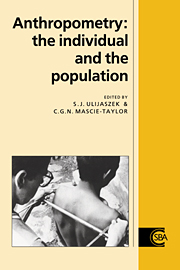Book contents
- Frontmatter
- Contents
- List of contributors
- Preface
- Acknowledgements
- 1 The place of anthropometry in human biology
- 2 Asymmetry and growth
- 3 Intra- and inter-observer error in anthropometric measurement
- 4 Statistical issues in anthropometry
- 5 Statistical constructs of human growth: new growth charts for old
- 6 Growth monitoring and growth cyclicities in developed countries
- 7 Growth monitoring, screening and surveillance in developing countries
- 8 Variability in adult body size: uses in defining the limits of human survival
- 9 Anthropometry and body composition
- 10 Anthropometry and physical performance
- 11 Anthropometry, strength and motor fitness
- 12 Anthropometry in the US armed forces
- Index
Preface
Published online by Cambridge University Press: 19 November 2009
- Frontmatter
- Contents
- List of contributors
- Preface
- Acknowledgements
- 1 The place of anthropometry in human biology
- 2 Asymmetry and growth
- 3 Intra- and inter-observer error in anthropometric measurement
- 4 Statistical issues in anthropometry
- 5 Statistical constructs of human growth: new growth charts for old
- 6 Growth monitoring and growth cyclicities in developed countries
- 7 Growth monitoring, screening and surveillance in developing countries
- 8 Variability in adult body size: uses in defining the limits of human survival
- 9 Anthropometry and body composition
- 10 Anthropometry and physical performance
- 11 Anthropometry, strength and motor fitness
- 12 Anthropometry in the US armed forces
- Index
Summary
This book examines the various ways in which anthropometric measurements are used and interpreted in a range of disciplines, including biological anthropology, human biology, clinical medicine, applied physiology, health sciences and ergonomics. Anthropometry can be used to define population characteristics or to assess individuals with respect to some physical parameter, and the dual nature of this methodology is addressed by many of the authors.
The introductory chapter by G.W. Lasker discusses the role that anthropometry plays in studies of human biology, and examines the history of anthropometric measurement. The use of anthropometry in discriminating the pathological from the normal is a theme which appears in the first chapter, and is developed further by P.H. Dangerfield, who considers asymmetry in human growth, and why it is important to define what is ‘normal’ asymmetry. Accurate measurement is important in any science, and S.J. Ulijaszek and J.A Lourie review what is known about measurement error in anthropometry and put forward references for maximum acceptable error. In the chapter which follows, C.G.N. Mascie-Taylor considers statistical issues and approaches when analysing cross-sectional anthropometric characters in groups or populations.
Growth charts are widely used for growth monitoring in both developed and developing countries, and the next three chapters consider different aspects of monitoring. In the first of these, T. J. Cole describes different types of growth chart and the principles underlying them, and elaborates on new types of conditional height charts which he has developed. In the subsequent chapter, S.J. Ulijaszek considers the importance of understanding human growth cyclicities in relation to accurate growth monitoring in Western nations, while in the third of these, A.M.
- Type
- Chapter
- Information
- AnthropometryThe Individual and the Population, pp. xi - xiiPublisher: Cambridge University PressPrint publication year: 1994



